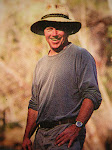There’s no simple way to get to Burnt Island, the large, brooding landmass in the southeast corner of Lochloosa Lake. For Charlie, the legendary “Poet of Burnt Island” introduced to most of us by J.T. Glisson in his book, The Creek, it was a cypress rowboat. According to Glisson, it was a heavy boat, but it probably served Charlie well as he eked out a humble living fishing for brim and specks and running trotlines for catfish on Lochloosa Lake. The only time his sturdy craft served a more ambitious task was when it carried Charlie on his annual pilgrimage up the Creek and across Orange Lake to the town of Orange lake, where he bought four jugs of wine and a couple of gin. Thus supplied, he would then paddle out into the lake, tie the craft to a floating island and indulge in a glorious, multi-day drunk. (I recommend you read The Creek to enjoy the rest of this fun [though a bit tragic] story).
For Marjorie Kinnan Rawlings, it was a horse, a sense of duty and a friend with a poor sense of direction that brought her to Burnt Island. Hoping to get better acquainted with the people of Cross creek, Rawlings accompanied her friend (at the time) Zelma Cason on a two day horseback ride through the countryside to take a census. On the second day, as they neared Burnt Island, Zelma described “fabulous tales” of the “grandfather of all rattlesnakes” and “savage, long-tusked and dangerous” wild boars that lived there. “The place was also a hide-out for criminals who preferred the great rattler and wild boars to the long arm of the law.” Dusk was fast approaching and Rawlings found little comfort in the stories. She was even less thrilled when Zelma confessed that she had missed a turn and they were now lost--on the fringes of Burnt Island! The two ladies survived the ordeal with the help of stout hearts and a full moon. Unfortunately their friendship did not fare as well. When Rawlings recounted the event in her book, Cross Creek, (in the chapter titled, “The Census”) her descriptions of Zelma were less than flattering and Zelma sued.
Today, the island is part of the 10,388 acre Lochloosa Wildlife Conservation Area that surrounds much of Lochloosa Lake. Land access to the island is little better than in Rawlings day. A simple LWCA sign alongside State Road 301, near Grove Park, calls attention to a small dirt road entering the forest. Here, I would advise all curious nature lovers to answer your primal attraction to such wild places and turn in. Following this rough dirt road, you’ll thread through pine plantations and mixed hardwoods before crossing a small dike—the umbilicus that connects the island to the mainland. Continuing on, you’ll soon come to a quiet, oak-shaded park and fishing pier. Beyond this little park, the road continues another quarter mile through the dense mixed hardwood hammock, becoming less drivable with every bend and finally surrendering to the forest where it morphs into a walking trail.
 |
The best way to reach Burnt Island is by kayak or canoe, launching from the village of Cross Creek on the beautiful little stream for which it was named. Leaving the creek, the cypress forests end and marshes slowly give way to the vast open expanse of Lochloosa Lake. The brooding, deep-green tree line of Burnt Island looms in the distance. As you skim past floating meadows of spatter dock and cattails, water birds of all tribes move about. The island grows larger and the trees become better defined. Reaching the island, you find a huge cormorant roost, so popular that the trees are chalky white from years of discharge. You pass the site of old Charlie’s shack. You can almost picture the tin Prince Albert can he nailed to a cypress tree for people to pick up money and his notes requesting supplies. You see a movement in the forest shadows and could swear it was a wild boar. A breeze rustles the maidencane, or was it the sizzle of a distant rattler?
Gazing up into the tall pines, you are reminded that not all of Burnt Island’s wonders are of the past. A pair of bald eagle nests—both visible from a single vantage point—remind you that this is still a wildlife Mecca. The fuzzy little heads we see poking out of the nests in late winter remind us that some of the island’s greatest marvels are yet to come.



No comments:
Post a Comment